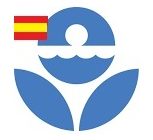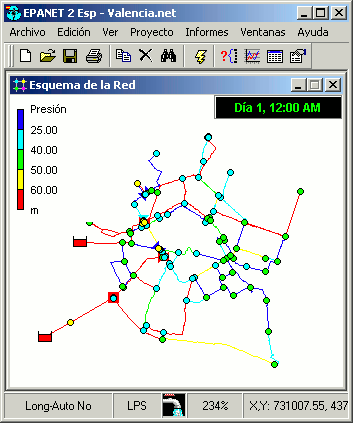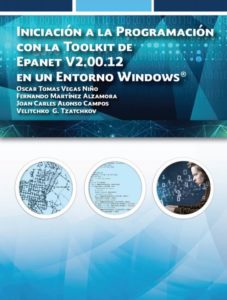EPANET 2.00.12 ESP
Software That Models the Hydraulic and Water Quality Behavior of Water Distribution Piping Systems

Description
Characteristics
Images
Downloads
Toolkit EPANET Book
Description
EPANET is software that models water distribution piping systems. EPANET is public domain software that may be freely copied and distributed. It is a Windows 95/98/NT/XP program. EPANET performs extended period simulation of the water movement and quality behavior within pressurized pipe networks.
Pipe networks consist of pipes, nodes (junctions), pumps, valves, and storage tanks or reservoirs. EPANET tracks:
- the flow of water in each pipe,
- the pressure at each node,
- the height of the water in each tank,
- the type of chemical concentration throughout the network during a simulation period,
- water age,source, andtracing.
Characteristics
- There is no limit in the size of the network that can be processed.
- Load losses can be calculated using the Hazen-Williams, Darcy-Weisbach and Chezy-Manning formulas.
- Contemplate minor losses in elbows, accessories, etc.
- It accepts fixed or variable speed pumps.
- It can calculate the energy consumption and its costs.
- It allows to consider several types of valves, such as shut-off valves, check valves, and pressure or flow regulators.
- It accepts deposits of variable geometry (that is, whose diameter varies with the level).
- It allows to consider different types of demand in the nodes, each with its own curve of modulation in time.
- It can model water intakes whose flow depends on pressure (eg. sprinklers).
- It allows simple control laws, based on the value of the level in the deposits or the time set by a timer, and more complex control laws based on logical rules.
- In addition, as a tool for the analysis of water quality, EPANET offers the following additional features:
- It simulates the displacement of nonreactive tracers throughout the network, over time.
- It simulates the progress and evolution of reactive substances whose concentration either increases over time (eg. by-products derived from disinfection) or decreases (eg. residual chlorine).
- It simulates the residence time (or aging) of the water as it flows through the net.
- It allows to follow the evolution of flow fraction time that reaches each node of the network coming from a certain node (provenance analysis).
- It simulates the reactions that take place both inside the water and on the walls of the pipes.
- It allows to use n-order kinetics to model the reactions within the water.
- It uses zero order or first order kinetics to model the reactions on the pipe walls.
- It takes into account the limitations of mass transfer when modeling the reactions in the walls of the pipes.
- It admits reactions of growth or decrease of the concentration of a substance until reaching a limit value.
- It allows to define global reaction coefficients for the whole network, and to modify these later for certain pipes.
- It allows to consider the injection in any point of the network of a mass flow or of defined concentration, or a variable in the time.
- The evolution of water quality in tanks can be simulated as a homogeneous mixture, using a piston model, or as a two compartment reactor.
The EPANET Windows user interface provides a graphic editor that simplifies the process of tracing the network schema and defining the properties of its components. It also offers different options for interpreting and analyzing the results of an analysis, such as plotting evolution curves, longitudinal profiles or isoline maps, making tabulated tables with filters, and preparing specific reports oriented to calibration, the evaluation of energy consumption or the evaluation of the reactive substances.
Images
Downloads
La versión española de EPANET 2.00.12 incluye la Interfaz Gráfica, el Módulo de Herramientas, el Manual del Usuario completo de ambos, y todos los ficheros de ayuda. Además contiene algunas mejoras respecto a la versión inglesa original, que pueden consultarse al final del fichero de Actualizaciones.
No se ofrece por ahora la extensión para multi-especies en español.
Los ficheros que siguen se pueden descargar y copiar libremente. Sin embargo, se prohíbe distribuir los mismos desde otras páginas web, salvo autorización expresa. En su lugar, enlazar con la presente página para estar al día de cualquier actualización.



